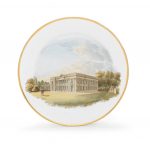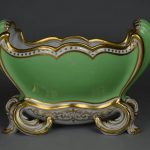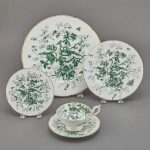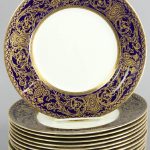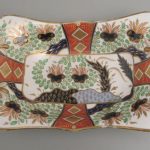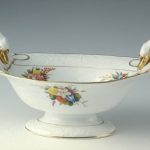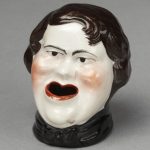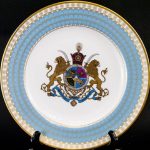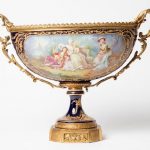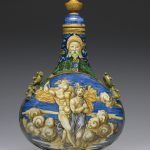Information and gallery of bone china. Bone china is a type of soft-paste porcelain that is composed of bone ash, feldspathic material, and kaolin. It has been defined as ware with a translucent body containing a minimum of 30% of phosphate derived from animal bone and calculated calcium phosphate. Bone china is the strongest of the porcelain or china ceramics, having very highly mechanical strength and chip resistance, and is known for its high levels of whiteness and translucency. Its high strength allows it to be produced in thinner cross-sections than other types of porcelain. Like stoneware it is vitrified, but is translucent due to differing mineral properties. Reference: Wikipedia
A Wedgwood bone china plate, circa 1812-22 Painted with a ‘N E View of Sutton Hall, Derbyshire, The Seat of Clement Hynnersley Esq’, a fine classical country house admired by a couple out walking in the grounds, within a gilded rim, 20.7cm diam, uppercase mark in red
Sold for £ 275 inc. premium at Bonhams in 2018
Vase, bone china, moulded, of bombé form with scroll feet, based on the Sèvres ‘cuvette Mahon’, green ground, with gilt decoration. Producer nameFactory of: Worcester Porcelain Factory (as Flight, Barr & Barr) biography Date1830 (circa)
Reference: © The Trustees of the British Museum
Coalport Bone China Dinner Service Approximately sixty pieces.
12 dinner plates 12 salad plates 12 bread plates 12 teacups and saucers CAIRO pattern Overall good condition. Some very light wear from occassional use.
Sold for $562 (includes buyer’s premium)
Royal Worcester bone china, Embassy pattern, twelve (12) dinner plates, 10 1/2″ diameter.
Sold for $250 at Kaminski Auctions in 2018
Established in Staffordshire in 1770, the Spode Pottery perfected bone china and manufactured an exceptional range of wares and patterns. From the outset, its pieces were virtually devoid of faults with porcelain that did not craze or go creamy, enamel colours that did not flake, and gilding that remained lustrous. These qualities distinguished Spode from most other porcelain produced in England. Spode remained the principal porcelain factory in Staffordshire until 1883 when it became Copeland & Garrett.
Reference: Museum of Applied Art and Sciences
Bone China Comport about 1810 Josiah Spode II
Oval bowl, white ground, two swan handles, 3 separated bouquet of flowers painted inside of bowl and 3 around the outside; gilt trim. Mark: 1660 on bottom.
p>Reference: Museum of Fine Arts Boston
Ink pot of bone china in the form of a grotesque head of a beardless man. He has brown hair, an open mouth and black collar.
Place of Origin: Staffordshire ca. 1810
Reference: © Victoria and Albert Museum
Spode Commemorative Plate of Imperial Persia. A Spode commemorative bone china imperial plate of Persia. Limited edition, gilt maker’s marks, 1971, the parcel gilt and polychrome enameled dinner plate with a gilt rim and conforming border of continuous florettes above a turquoise blue ground band of stylized tapering scales pattern enclosing the intricately detailed armorial shield of Shah Mohammad Reza Pahlavi, opposite an underside centering gilt Farsi text above English text “THE IMPERIAL PLATE OF PERSIA WITH THE APPROVAL OF HIS IMPERIAL MAJESTY MOHAMMAD REZA PAHLAVI ARYAMEHR, SHAHANSHAH OF IRAN. THIS PLATE HAS BEEN PRODUCED IN 1971 IN A LIMITED EDITION OF 10,000 TO COMMEMORATE 2,500 YEARS OF PERSIAN MONARCHY.” 10.5 inches in diameter.
Sold for $125 at Greenwich Auction in 2018
